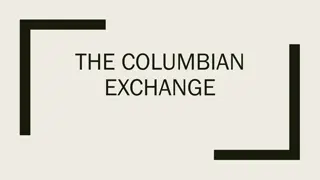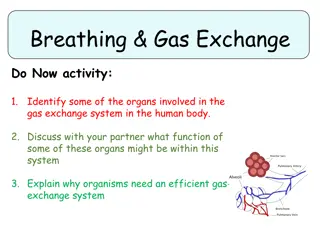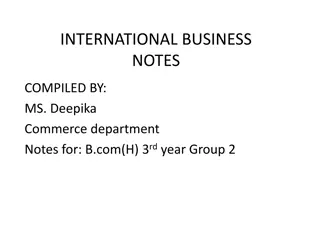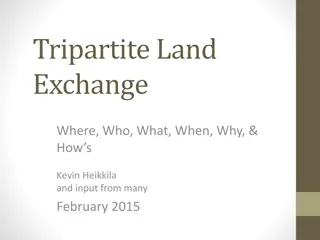The Columbian Exchange: Key Concepts and Impacts
Explore the significant social, cultural, and political changes brought about by the Columbian Exchange between Europeans, Native Americans, and Africans. Learn about the exchange of goods, technology, and the impact on societies across different continents. Discover the reasons for European exploration, the impacts of the exchange, and the role of technology and trade in this transformative period.
Download Presentation

Please find below an Image/Link to download the presentation.
The content on the website is provided AS IS for your information and personal use only. It may not be sold, licensed, or shared on other websites without obtaining consent from the author. Download presentation by click this link. If you encounter any issues during the download, it is possible that the publisher has removed the file from their server.
E N D
Presentation Transcript
www.Apushreview.com HomeButton.png Period 1: 1491 - 1607 APUSH Review: Key Concept 1.2 (The Columbian Exchange) Shout-out Time: Shout-out to Ms. Peinado s class. You are brilliant! Everything You Need To Know About Key Concept 1.2 and The Columbian Exchange To Succeed In APUSH Updated for the 2015 revisions
HomeButton.png The New Curriculum and The Columbian Exchange Key Concept 1.2 Contact among Europeans, Native Americans, and Africans resulted in the Columbian Exchange and significant social, cultural, and political changes on both sides of the Atlantic Ocean. Page 26 of the Curriculum framework The Columbian Exchange revolutionized life in the Americas, Europe, and Africa. Big Ideas: What were positives and negatives of the Columbian Exchange on both hemispheres? What were reasons that led to European exploration?
HomeButton.png Key Concept 1.2, I Key Concept 1.2, I: European expansion into the Western Hemisphere generated intesnse social, religious, political, and economic competition and changes within European societies. Page 26 of the Curriculum framework A) Reasons for European exploration: Countries sought new sources of wealth gold and silver Economic and military competition glory (defeat of the Spanish Armada by the English) Spread Christianity Spain The Spanish often tried to convert Natives to Christianity Spanish Mission System: Outposts throughout the Americas to help convert Natives Outposts were often military bases as well 3 G s Gold, Glory, Gospel
HomeButton.png Key Concept 1.2, I B) Columbian Exchange and its impacts What was it? The exchange of plants, animals, culture, humans, diseases, etc. between the Americas, Europe, and Africa Examples of goods: Americas to Europe and Africa: potatoes, maize (corn), tomatoes Europe to the Americas: wheat, rice, horses, chickens, oxen Impact of exchange? In Europe and Asia: massive population growth due to new food; increase in wealth; decrease in feudalism and a rise of capitalism In Africa: Spanish and Portuguese used Africans from West Africa to be used as slaves in the Americas In the Americas: spread of diseases (smallpox and measles), social classes (Mestizos), horse transformed Native life (made hunting easier), Encomienda system
HomeButton.png Key Concept 1.2, I C) Technology and trade New technology aided exploration: Sextant could be used to find exact position on earth more precise sailing Caravel, compass, and quadrant improved sailing efficiency Economic improvements: Joint-stock companies used to raise $ for explorations Used in Jamestown (1607)
HomeButton.png Key Concept 1.2, II Key Concept 1.2, II: The Columbian Exchange and development of the Spanish Empire in the Western Hemisphere resulted in extensive demographic, economic, and social changes. Page 27 of the Curriculum framework A) Impact of Spanish exploration: Deadly diseases: Smallpox, malaria Killed as many as 90% of Natives in some areas not immune to European diseases Introduction of new animals and crops: Horse transformed Native life on the Great Plains Crops wheat, rice, and sugar
HomeButton.png Key Concept 1.2, II B) Encomienda System (Check out video in the description) Native American labor was marshaled (arranged, assembled) on plantations The goal was to use labor for agriculture and gain precious metal Eventually, the encomienda system was replaced by African Slave Labor New Laws of 1542 outlawed the encomienda system C) Spanish and Portuguese traders acquired slaves from some West African groups Slaves were used by the Spanish on plantations and mines D) Spanish Caste System: Incorporated Europeans, Africans, Natives Europeans were at the top (peninsulares and creoles) Mestizo and mulatos (mixed European and Native, European and African ancestry)
HomeButton.png Key Concept 1.2, III Key Concept 1.2, II: In their interactions, Europeans and Native Americans asserted divergent worldviews regarding issues such as religion, gender roles, family, land use, and power. Page 28 of the Curriculum framework A) Misunderstandings between each group Gender many Natives societies were matrilineal Land Natives did not own individual land Religion Natives believed in animism, polytheistic; shamans held power Some useful aspects of each other s cultures were eventually adapted: Natives adapted technology Europeans adapted agriculture techniques
HomeButton.png Key Concept 1.2, III B) Native resistance to European encroachment and labor: Natives sought to preserve political, economic, and religious autonomy (independence, self-rule) Diplomatically and/or militarily C) Debates over how non-Europeans should be treated: Many Europeans saw Natives and Africans as savages Juan de Sepulveda: Advocated harsh treatment of Natives Claimed slavery for Natives was justified under Christianity Bartolome de Las Casas: Argued that Natives deserved the same treatment as all other men Played an instrumental role in the ending of the encomienda system Contributed to the Black Legend Arguments used to subjugate Africans and Natives? Racism, religious - spread of Christianity, Natives and Africans were seen as barbaric
HomeButton.png Test Tips Multiple-Choice Questions and Short Answer: Be familiar with the impacts of the Columbian Exchange not just food Increase in world trade, permanently connecting two hemispheres Identify specific goods and their impacts horse and potato Encomienda System Impact on Africans drastic growth in slavery Essay Questions: European interactions with Native Americans Could be part of larger topic comparing Spanish colonization with other European countries (Period 2)
HomeButton.png See You Back Here For Key Concept 2.1! Thanks for watching! Good luck in May Please subscribe and share Check out APUSHReview.com for many more resources Practice Multiple-Choice Questions New Short Answer Question every Monday!























